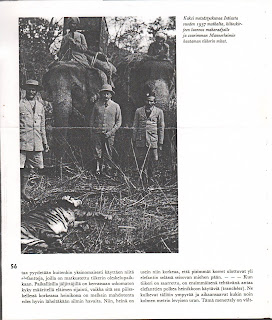Perhaps the first Finnish tourist in the Himalayan Kingdom was Marshal Mannerheim. Nepal was better known then as a kingdom in the clouds, almost inaccessible, and a paradise for big game hunters from Europe, guests of the British Empire visiting their Indian dominion. The Royal Bengal Tigers, the Great Indian One-horned Rhinoceros and the Wild Indian Bisons roamed free in the dense jungles of Southern Nepal. Emperors and kings, dukes and princes all have made their way to the Nepal Terai to shoot the tiger.
Just who was this famous personality? Carl Gustav Mannerheim was the hero of of the Finnish Civil War fighting for the Whites against the Red Bolsheviks. He was the Commander-in-Chief of the Finnish Defense Forces during World War II, Marshal of Finland and later became the sixth President of Finland towards the end of the war (1944-46).
 |
| Marshal Mannerheim in 1940 |
 |
| Marshal Mannerheim at his tiger shoot |
This lure of Nepal for adventure and romanticism brought Marshal Mannerheim for his first Nepal visit at the invitation of the British Resident in Nepal. But bigger things were still to come. After bagging his first Nepalese tiger Marshal Mannerheim made his way back to Southern India and visited Madras and Hyderabad. When he returned in February 1937 he was to visit Nepal as the personal guest of His Highness Maharaja Juddha Shumsher Jung Bahadur Rana, Prime Minister of Nepal.
The ruling Rana family had wrested state powers from weak dynastic rule of the Shah kings in the famous coup d’état of 1847. Jung Bahadur Rana was the first Prime Minister to visit England at the invitation of Queen Victoria’s court thus making a name for himself as a wily old fox who had outsmarted many bigger and more powerful Indian Maharajahs into getting this invitation. But he also firmly placed Nepal on the map as the supplier of British armies with Gurkha soldiers from the Nepalese hills and the host of many a diplomatic tiger shoot. Never again were the British to attack Nepal after the ill-fated war of 1814.
 |
| Mannerheim’s note to Maharajah Juddha |
Against this backdrop Marshal Mannerheim was feted at the camp in south Nepal by Maharajah Juddha, the hunting only part of the great game of statesmanship by which the Ranas preserved Nepalese sovereignty. Maharajah Juddha himself was a formidable hunter with over 200 tigers to his name. Marshal Mannerheim writes in his memoirs, “The day after my arrival, accompanied by Colonel Bailey (British Resident), I paid a visit to the Maharajah in his camp, to which a specially constructed road led. During the drive I saw an unforgettable sight – one hundred and eighty elephants advancing with their soft, silent gait on their way to surround more tigers. The Maharajah was accompanied by a thousand retainers and two hundred elephants, and his camp was like a city of tents and surrounded by a strong palisade.” Marshal Mannerheim accomplished his goal of shooting his male tiger, 10 feet and seven inches in length, the biggest that was shot that year in Nepal. He also visited Kathmandu Valley at the invitation of the Maharajah.
 |
| Maharajah Juddha and Marshal Mannerheim |
In the Mannerheim Museum in Helsinki housed in a white villa that used to be the residence of the marshal until his death in 1951 A.D. is displayed the tiger skin with a mounted head he bagged in Nepal along with a photograph of him with Maharajah Juddha. History will always remember him as the first visitor to Nepal from Finland!


